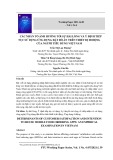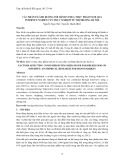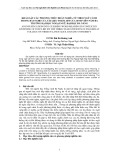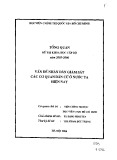
Hindawi Publishing Corporation
EURASIP Journal on Advances in Signal Processing
Volume 2009, Article ID 927140, 12 pages
doi:10.1155/2009/927140
Research Article
Modeling Misbehavior in Cooperative Diversity:
A Dynamic Game Approach
Sintayehu Dehnie1and Nasir Memon2
1Department of Electrical and Computer Engineering, Polytechnic Institute of New York University, 5 MetroTech, Brooklyn,
NY 11201, USA
2Department of Computer and Information Science, Polytechnic Institute of New York University, 5 MetroTech, Brooklyn,
NY 11201, USA
Correspondence should be addressed to Sintayehu Dehnie, sintayehu@isis.poly.edu
Received 1 November 2008; Revised 9 March 2009; Accepted 14 April 2009
Recommended by Zhu Han
Cooperative diversity protocols are designed with the assumption that terminals always help each other in a socially efficient
manner. This assumption may not be valid in commercial wireless networks where terminals may misbehave for selfish or
malicious intentions. The presence of misbehaving terminals creates a social-dilemma where terminals exhibit uncertainty about
the cooperative behavior of other terminals in the network. Cooperation in social-dilemma is characterized by a suboptimal Nash
equilibrium where wireless terminals opt out of cooperation. Hence,without establishing a mechanism to detect and mitigate effects of
misbehavior,it is difficult to maintain a socially optimal cooperation. In this paper, we first examine effects of misbehavior assuming
static game model and show that cooperation under existing cooperative protocols is characterized by a noncooperative Nash
equilibrium. Using evolutionary game dynamics we show that a small number of mutants can successfully invade a population of
cooperators, which indicates that misbehavior is an evolutionary stable strategy (ESS). Our main goal is to design a mechanism
that would enable wireless terminals to select reliable partners in the presence of uncertainty. To this end, we formulate cooperative
diversity as a dynamic game with incomplete information. We show that the proposed dynamic game formulation satisfied the
conditions for the existence of perfect Bayesian equilibrium.
Copyright © 2009 S. Dehnie and N. Memon. This is an open access article distributed under the Creative Commons Attribution
License, which permits unrestricted use, distribution, and reproduction in any medium, provided the original work is properly
cited.
1. Introduction
Cooperative wireless communications is based on the princi-
ple of direct reciprocity where wireless terminals attain some
of the benefits of multiple input multiple output (MIMO)
systems through cooperative relaying, that is, by helping each
other. Since direct reciprocity is “help me and I help you”
kind of protocol, a terminal will be motivated to help others
attain cooperative diversity gain with the anticipation to reap
those same benefits when the helped terminals reciprocate.
When all terminals obey rules of cooperation, a stable and
socially efficient cooperation is realizable, which may be
true in wireless networks under the control of a single
entity wherein terminals cooperate to achieve a common
objective, as in military tactical networks. On the other
hand, in commercial wireless networks where terminals are
individually motivated to cooperate, the assumption that
terminals will always obey rules of cooperation may not
hold: (1) terminals may misbehave and violate rules of
cooperation to reap the benefits without bearing the cost, (2)
well-behaved terminals may refuse to relay for their poten-
tial partners without the assurance that the partners will
reciprocate. While the first reason is motivated by a selfish
intention to save energy, the second reason is motivated by
the absence of mechanisms to incentivize cooperation in
existing cooperative protocols. Hence, in commercial wireless
networks, it is difficult to ensure a stable and socially efficient
cooperation without implementing a mechanism to detect and
mitigate misbehavior.
Game theoretic approaches have been proposed to design
mechanisms that incentivize cooperation in commercial
wireless networks. The proposed mechanisms belong to
either price-based or reputation-based schemes. In price-
based cooperation [1,2], terminals are charged for channel

2 EURASIP Journal on Advances in Signal Processing
use when transmitting their own data and get reimbursed
when forwarding for other terminals. It is shown that the
pricing scheme leads to a Nash equilibrium that is Pareto-
superior. In reputation-based schemes [3,4], the authors
proposed Generous Tit for Tat (GTFT) algorithm which
conditions the behavior of nodes based on their past history.
The authors showed that if the game is played long enough,
GTFT leads to an equilibrium point that is Pareto-optimal.
The game theoretic models in the aforementioned works
in particular and in literature in general, consider a static
game model where players are assumed to make decisions
simultaneously. Since simultaneous decision making implies
that players are unable to observe each other’s actions, static
game models do not capture well dynamics of cooperative
interactions. Recently a dynamic Bayesian game framework
has been proposed to model routing in energy constrained
wireless ad hoc networks [5], which provides the motivation
for our work.
Motivated by the inadequacy of static game models to
fully characterize cooperative communications, we formu-
late interactions of terminals in cooperative diversity as a
dynamic game with incomplete information. The dynamic
game formulation captures temporal and information struc-
ture of cooperative interactions. Temporal structure of
a dynamic game defines the order of play: cooperative
transmissions occur in sequential manner wherein a source
terminal transmits first and then potential cooperators
decide to either cooperate or deviate from cooperation. The
sequential nature of cooperative transmissions is dictated
by the half-duplex constraint of wireless devices, that is,
a relay terminal cannot receive and transmit at the same
time in the same frequency band. The information structure
of dynamic games characterizes what each player knows
when it makes a decision: in commercial wireless networks,
intention of each user is not known a priori, hence,
incomplete information specification of the game represents
the uncertainty each user has about the intention of other
users in the network. In this paper, we present a general
dynamic game framework that may fit any of the existing
cooperative diversity protocols. We show that the proposed
model captures important aspects of existing cooperative
diversity protocols. We also show that the proposed dynamic
game formulation satisfies the requirements for the existence
of perfect Bayesian equilibrium.
This paper is organized as follows. In Section 2, the
system model is described. In Section 3, game theoretic
analysis of cooperative diversity is presented. Background
of dynamic games is presented in Section 4.InSection 5,a
dynamic game framework is presented. Finally, in Section 6,
concluding remarks are given.
2. System Model
We consider N-user TDMA-based cooperative diversity
system wherein terminals forward information for each
other using any one of the existing cooperative schemes.
We assume that a source terminal randomly selects utmost
one potential cooperator (relay) among all its neighboring
terminals. It is important to note that random selection
j
i
D
Figure 1: Wireless cooperative network.
of potential cooperators indicates the assumption held by
all terminals that their relay terminals are always willing to
help. A source terminal and its potential partner establish a
possible cooperative partnership prior to data transmission
by exchanging control frames. Through the established
cooperative partnership, terminals enter into a nonbinding
agreement to forward information for each other (see
Figure 1). Details of the mechanism by which cooperative
partnerships are formed is beyond the scope of this work as
our primary focus is on examining the sustainability of this
partnership.
The interterminal channels are characterized by Rayleigh
fading. We denote by γs,d,γs,r,γr,dinstantaneous signal-
to-noise ratio (SNR) of source-destination, source-relay, and
relay-destination channels. Information is transmitted at a
rate of Rb/sin a frame length of M-bits. We assume that all
users transmit at the same power level and modulation/rate.
3. Game Theoretic Analysis of
Cooperative Diversity
3.1. Two-User Cooperation. In this section, we examine
the cooperative interaction between terminals within the
framework of noncooperative game theory. We assume
that the benefits of cooperation and the cost it incurs are
common knowledge. That is, terminals are willing to expend
their own resources to help other terminals achieve reliable
communication with the expectation to achieve those same
benefits when the helped terminals reciprocate. We assume
that terminals are individually rational in that terminals
behave in a manner to maximize their individual benefits
from cooperation. We assume rational behavior of terminals
is common knowledge, that is, terminals know that other
terminals are rational. Individuality rationality is crucial for
the evolution of cooperation as it states that well-behaved
terminals have strong preference for partners that conform
to rules of cooperation. On the other hand, individual
rationality may lead to selfish behavior where a terminal
is tempted to economize on cost of cooperation (energy)
while reaping the benefits. We show that in the presence of
selfish users, individual rationality dominates cooperation
which would consequently lead to a noncooperative Nash
equilibrium that is suboptimal in the Pareto sense.
We denote the strategy available to all terminals by Θ
where Θ∈{θ0=cooperate, θ1=misbehave}, that is, Θis

EURASIP Journal on Advances in Signal Processing 3
the strategy space of the game. Source terminal Sitransmits
to the network whenever it has information to send. Thus,
its strategy space is a singleton and is denoted by Θi.On
the other hand, relay terminal Rjmay either obey the rules
of cooperation or deviate from it. Thus, the strategy space
of Rjis a nonsingleton set which is defined as Θj={θ0=
cooperate, θ1=misbehave},whereθj∈Θjis pure strategy
of Rj. We assume that a misbehaving relay node Rjadopts
mixed strategy where it plays pure strategyθjwith probability
pj(Θj). It is obvious that mixed strategy incurs uncertainty
in the game since source terminal Sihas no knowledge
whether Rjconforms to cooperation or violates it. Terminal
Rjbeing a rational player will adopt this strategy to confuse
its partner by mimicking the unpredictable nature of the
wireless channel. From a game-theoretic viewpoint, mixed
strategy ensures that the game has Nash equilibrium.
The utility function of terminal Siis defined in
terms of cooperative diversity gain which is denoted by
ui(pi(Θi), pj(Θj)), where pj(Θj)capturesbehaviorofits
partner. In the next section, we formally define the utility
function for cooperative diversity in terms of achievable
performance gains at the physical layer. For the purpose
of simplifying the discussion in this section, achievable
cooperative diversity gain when all terminals obey the
rules of cooperation is denote by ρc. On the other hand,
when all terminals opt out of cooperation, each terminal
derives a degraded cooperative diversity gain compared to
the attainable benefit; this utility is denoted by ρnc where
obviously ρnc <ρ
c. We assume that each terminal expends a
fraction of its available power for cooperation, which defines
the cost of cooperation and is denoted by cc. We assume
that the cost of cooperation is strictly less than the attainable
cooperation benefit, that is, cc<ρ
c. The utility matrix of the
game is then
U=⎛
⎝ρc−ccρnc −cc
ρcρnc
⎞
⎠,(1)
where ρc−ccis the net utility when all terminals cooperate,
ρnc −ccis the utility to a well-behaved terminal when
its partner deviates from cooperation. The terminal that
deviates from cooperation derives utility ρcat no cost and
ρnc is the noncooperative utility.
Suppose terminals iand jform cooperative partnership
where each terminal affirms its willingness to cooperate via a
protocol handshake. A willingness to cooperate may indicate
that a terminal has enough available power to expend for
cooperation. It may also indicate a terminal’s intent to
economize on the other terminal’s cooperative behavior. We
assume that both terminals iand jplay mixed strategies
when each terminal acts as a relay to help the other terminal.
Their mixed strategies, respectively, are
Pi=pi(θ0)pi(θ1),Pj=pj(θ0)pj(θ1),(2)
where pj(θ0) is the probability with which relay terminal Rj
cooperates with source terminal Si,andpj(θ1)isprobability
of misbehavior. Similarly pi(θ0)pi(θ1) capture probabilities
of cooperation and misbehavior when terminal iacts as a
relay to terminal j. The expected net utility function of each
terminal can be shown as
uipi(Θi),pjΘj=PiUPT
j
=pj(θ0)ρc+1−pj(θ0)ρnc
−pi(θ0)cc,
ujpjΘj,pi(Θi)=PjUPT
i
=pi(θ0)ρc+1−pi(θ0)ρnc
−pj(θ0)cc,
(3)
where [ ]Tis the transpose operator.
When both terminals obey the rules of cooperation
(pi(θ0)=1, pj(θ0)=1), each derives a net utility of
ρc−cc. We examine next steady-state behavior of the game
when either player deviates from cooperation by adopting
mixed strategy. Let us consider the case where terminal j
is a potential cooperator that plays mixed strategyPj.The
goal of an individually rational and mixed strategy playing
terminal jis as follows: (1) maximize its net expected utility
by minimizing the cost of cooperation and (2) behave in a
manner that make it difficult for terminal ito distinguish
between effects of channel dynamics and misbehavior.
Thus, terminal jstrategically selects Pj(mimicking inherent
uncertainty of the wireless channel) in such away that player
iis indifferent in expected net utility. That is, player jchooses
amixed strategy where player iwould achieve the same
expected utility irrespective of the strategy terminal jplays.
If such a mixed strategy exists, it means that in the long-run
terminal imay be unable to learn about the behavior of its
partner.
However, terminal iis a rational player and will learn in
the long run about the behavior of its potential partner by
observing its utility. In wireless communications, quality of
service metrics such as target frame error rate (FER) help
terminals determine degradation in achievable cooperative
diversity performance gain. Thus, there is no Pjthat will
make terminal iindifferent in expected utility. Due to the lack
of indifferent strategy that could confuse its partner, rational
player jwill reason that it can forgo the cooperation cost (i.e.,
pj(θ0)=0) in order to maximize its expected net utility.
It is obvious to see from (3) that if player iis well behaved
(pi(θ0)=1) and player jmisbehaves (pj(θ0)=0), player
iwould derive net expected utility of ui(pi(Θi), pj(Θj)) =
ρnc −cc. On the other hand, the misbehaving partner jwould
achieve expected utility uj(pj(Θj), pi(Θi)) =ρc. Note that
(1 −pj(θ0))ccis an amount of energy terminal jsaves by a
misbehaving.
Similarly, for the case of mixed strategy play by terminal
i, the same arguments can be applied to show that there is no
Pithat will make player jindifferent in expected net utility,
which indicates that a selfishly rational player iwill also be
tempted to forgo the cooperation cost (i.e., pi(θ0)=0) to
derive a net expected utility ui(pi(Θi), pj(Θj)) =ρc.Thus,
an individually rational terminal iwill play pi(θ0)=0to
achieve the highest utility irrespective of the strategy adopted

4 EURASIP Journal on Advances in Signal Processing
Pareto optimal cooperative strategy
(achievable when trust develops between players)
Sub-optimal Nash equilibrium
pi(θ0)
pj(θ0)
1
01
Figure 2: Best response functions in the mixed strategy noncoop-
erative game. It can be seen that the strategy combination (pi(θ0)=
1, pj(θ0)=1) is attained when trust develops between the players
which leads to the evolution of cooperation.
by its partner. For this reason, the steady-state behavior of
both players is characterized by the strategic combination
(pi(θ0)=0, pj(θ0)=0) which is a degenerate mixed strategy
Nash equilibrium. Hence, the optimal strategy of both ter-
minals is to deviate from cooperation: (1) for selfish reasons
where a relay terminal exploits cooperative behavior of other
terminals to economize on cost of cooperation; (2) to avoid
being economized on. Thus, at steady state each terminal
opts out of cooperation, where in terms of the best response
function of each player (Figure 2); if pi(θ0)=0, then player
j’s unique best response is pj(θ0)=0andviceversa.
We have shown that the degenerate mixed strategy Nash
equilibrium of the game is (pi(θ0)=0, pj(θ0)=0) which
is suboptimal in the Pareto sense. Generally, the suboptimal
solution tells us that while well-behaved terminals are willing
to cooperate for the social benefit, misbehaving terminals
maintain their individual rationality to reap the cooperation
benefits at no cost, which leads to a social-dilemma. In
other words, while cooperation is a socially efficient strategy,
individually rational terminals reason that they can do
better by deviating from cooperation. Cooperation in social-
dilemma is characterized by a lack of trust among the players
since each terminal is uncertain about the intention of other
terminals in the cooperative network. In other words, the
attainable Pareto efficient cooperation requires terminals
to trust their partners and also to be trustworthy [6].
That is, by putting trust on their partners, terminals make
themselves vulnerable by cooperating; by being trustworthy
terminals become socially rational and avoid exploiting the
vulnerability of the other terminals.
Next we examine evolution of selfish behavior in mul-
tiuser cooperative networks. Particularly, we are interested in
how the presence of a group of terminals that jointly deviate
from cooperation affects cooperative communications. Since
the strategies dictated by Nash equilibrium are not stable if
a group of terminals jointly deviate to attain better utility,
we use evolutionary game theory approaches to examine
multilateral deviation by a group of misbehaving terminals.
3.2. Evolution of Selfish Behavior. We consider a cooperative
diversity system comprised of a population of terminals that
interact randomly to attain cooperative diversity gain. We
assume that at any given time a terminal can interact only
with utmost one partner in the population. Due to mobility,
we assume that every terminal iinteracts at least once with
every other terminal j,i/
=j.
Suppose that initially the population conforms to coop-
eration. Now assume that a small group of selfish terminals
(mutants) enter the cooperative diversity system. The ques-
tion we would like to answer is if the mutants can successfully
invade the cooperative diversity system.
Let nCdenote the initial number of cooperators and
nMdenote the number of mutants,notenM≪nC.The
rationale behind the presence of very few mutants is to show
vulnerability of cooperative diversity to misbehavior (see
Figure 3). We denote by pCand pMthe fraction of cooperat-
ing and misbehaving terminals, respectively. In other words,
nCterminals cooperate with probability pCwhile the rest of
the terminals deviate from cooperation with probability pM.
We assume that the population of cooperators and mutants
play pure strategy. Although cooperators and mutants adopt
pure strategy, the entire population plays mixed strategy.The
mixed strategy probability vector of the population is
P=pCpMT.(4)
The utility matrix of the game is defined in (1).
We examine the interaction within the population within
evolutionary game theory framework to characterize dynam-
ics of the spread of misbehavior in multiuser cooperative
diversity. Evolutionary game theory deals with constantly
interacting players that adapt their behavior by observing
their utilities. The evolution of strategies into higher util-
ity yielding strategies is characterized by using replicator
dynamics [7]. Replicator dynamics predicts the rate at
which strategies that yield higher utilities spread through
the network. Thus, for multiterminal cooperative diversity
system with utility matrix Uand mixed strategyPthat varies
continuously with time, the evolution of cooperation and
misbehavior is given by the replication equation:
˙
pC=pC(UP)1−PTUP,
˙
pM=pM(UP)2−PTUP,
(5)
where ˙
xdenotes the derivative, (UP)1and (UP)2are expected
utilities of cooperators and mutants,respectively:
(UP)1=pCρc+pMρnc −cc,(6a)
(UP)2=pCρc+pMρnc.(6b)
The first term on the right-hand side in (6a) is utility derived
from cooperator-cooperator cooperation while the second
term on the right-hand side in (6a) is utility derived from
cooperator-mutant cooperation; the third term is the cost
incurred by cooperators. Similarly, the first term on the right

EURASIP Journal on Advances in Signal Processing 5
Time, t
CM
M
M
C
C
CC
C
C
C
MC
C
C
M
CM
M
MC
CM
M
M
M
M
M
M
M
M
M
M
MM
CCooperator
MMisbehavingterminal
M
Figure 3: Evolution of misbehavior in cooperative diversity in the
absence of a mechanism to mitigate effects of deviation from the
rules of cooperation.
hand side in (6b) is utility derived from mutant-cooperator
cooperation while the second term is from mutant-mutant
cooperation which actually results in noncooperation. The
average utility of the population is
PTUP =pCρc−cc+pMρnc.(7)
It is evident that cooperators derive utility that is
strictly less than the average utility of the population, that is,
(UP)1<PTUP. On the other hand, mutants reap utility that
is well above the average, that is, (UP)2>PTUP.Dynamicsof
the game dictates that nodes observe their utilities and adapt
to strategies that provide higher utilities. In other words, low-
utility cooperators will start imitating strategy of mutants
(their misbehaving partners) and forgo the cooperation cost
in an attempt to achieve a higher utility. That is, low-utility
cooperators will learn that they can do better at the expense
of other nodes. Due to the absence of techniques to deter-
misbehavior, the number of misbehaving nodes (mutants)
increases monotonically while the number of cooperators
grows at a negative rate. This indicates that the mutants
successfully invade a relatively larger population of well-
behaved cooperators. A decrease in number of cooperators
indicates a reduction in the number of nodes that selfish
nodes will cheat on. The population will reach a steady state
where there is no cooperator left to exploit. The network
evolves to a noncooperative state where each node opts out
of cooperation as shown in Figure 4. Thus, noncooperation
is an evolutionary stable strategy (ESS) which means that
the presence of a few misbehaving nodes can drive away
cooperators from the Pareto optimal cooperative strategy.
ESSisrobustagainstcoalitionofcooperatorsthatattempt
to shift the equilibrium point toward cooperation. That is,
a small number of cooperators cannot invade a population
of misbehaving nodes. Thus, cooperation is an evolutionary
unstable strategy. Hence, we have shown that the presence
of misbehaving nodes impedes evolution of socially efficient
and stable cooperation.
Hence, without establishing a mechanism to detect and
mitigate effects of misbehavior, cooperative diversity will not
evolve into a stable system in which users interact in a socially
efficient manner to attain a Pareto efficient equilibrium. The
game theoretic analysis presented in this section assumes
a static game model where the order in which terminals
0
0.1
0.2
0.3
0.4
0.5
0.6
0.7
0.8
0.9
1
pC/pM
0 5 10 15 20 25 30 35 40
Time, t
Proportion of cooperating terminals
Proportion of misbehaving terminals
Figure 4: Evolution of misbehavior in cooperative diversity in the
absence of a mechanism to mitigate effects of deviation from the
rules of cooperation.
make decisions has not been taken into account. Indeed,
the order of play has no significance in the outcome of the
analysis since the goal has been to give insight into effects
of selfish behavior in existing cooperative schemes. While
the static game model proves useful in the analysis, due to
its simplicity it may not capture the underlying dynamics of
cooperative schemes. Even though evolutionary game theory
enables us to analyze dynamics of interaction of a population
of nodes, it does not provide a framework to capture
the complex structure of cooperative interactions. In the
next section, we characterize cooperative communications
within the dynamic Bayesian game framework which would
enable us to develop mechanisms that ensure evolution of
stable cooperation. The Bayesian dynamic game model fully
captures relevant details of cooperative interactions between
source and relay nodes. First we present background material
on dynamic games.
4. Dynamic Games: Background
Dynamic games model a decision-making problem where
the order of play and information available to each player are
very significant to understanding the decision of each player
[8,9]. While order of play characterizes sequential interac-
tions, information available to each player describes what
each player knows when making decisions. For instance,
cooperative interactions occur sequentially, that is, source
terminals always transmit first and then relay terminals
decide to either forward or drop the transmission. A dynamic
game is represented in extensive-form [10].
In extensive form, a game is represented in a tree structure
which describes the sequential interactions and evolution of
the game. The root of the tree where the game begins is the
initial decision node and is denoted by I.Anoninitial nodeD
















![Báo cáo seminar chuyên ngành Công nghệ hóa học và thực phẩm [Mới nhất]](https://cdn.tailieu.vn/images/document/thumbnail/2025/20250711/hienkelvinzoi@gmail.com/135x160/47051752458701.jpg)









